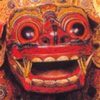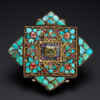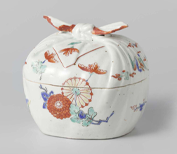J. KEITH WILSON
Curator of Ancient Chinese Art, Smithsonian’s National Museum of Asian Art

COMMEMORATING THE Freer Gallery of Art’s centenary, the National Museum of Asian Art has organised the exhibition, “Anyang: China’s Ancient City of Kings”, drawn entirely from its own holdings. The show is inspired by the parallel interests of Charles Lang Freer (1854–1919) in collecting Chinese antiquities and promoting scientific archaeology in China. One of his ambitions was the establishment of an American School of Chinese Archaeology in Beijing, which was intended to support training and professional practice, not build art collections in the United States and Europe. Partners in the plan included the Secretary of the Smithsonian, Chinese scholars and political leaders, university faculty members and wealthy supporters. Sadly, the goal was not achieved during Freer’s lifetime.
However, after the opening of the Freer Gallery in 1923, the ambition was revived when Carl Whiting Bishop (1881–1942), the museum’s first Chinese art curator, was dispatched to China with the goal of creating “a Chinese government-approved cooperation between American and Chinese scientific and archeological communities.” Positive developments began to occur after Bishop arranged to meet Li Chi (1896–1979), who had returned to China after receiving his Ph.D. in Anthropology at Harvard University. The two first met on March 9th, 1925, the day Bishop reached China after returning from a work-related trip to Washington, DC. At the time, Li served on the faculty of the recently established Nankai University. Over lunch with Archibald Wenley (1898–1962), also of the Freer, and Ding Wenjiang (1887–1936), founder of the Geological Survey of China, Bishop asked Li to join the Freer’s staff of field workers. Li requested time to consider the proposal, but stated he “would have rejected the offer outright if the actions of the Freer staff had not convinced him that the expedition intended to collaborate with its Chinese partners in the most equitable manner”.

Li officially joined the Freer on June 15th, 1925, the day his Nankai contract ended. At the time, he declared that he accepted the position with the understanding that any collaboration would be under the direction of a Chinese institution and no unearthed relics would leave the country. Within one year, Li had taken up residency at Tsinghua College, his Chinese alma mater, where a new Institute of Scientific Research had been established. This organisation evolved into Academia Sinica, a national organisation dedicated to scholarly enquiries in the sciences and humanities, not unlike the Smithsonian. One unit of Academia Sinica, the Institute of History and Philology (IHP), sought to advance scientific practices and train Chinese archaeologists. Li joined the new organisation; through Li and Bishop, the Freer and the Smithsonian began to partner with the emerging, modern organisation.
Just as the relationship was advancing, Academia Sinica began its first major project: exploratory surveys in a neighbourhood village called Xiaotun near Anyang, approximately 500 kilometres south-west of Beijing. The team was led there by evidence that it was the source of inscribed bones and turtle shells, popularly called “dragon bones” and now generally referred to as “oracle bones”, that carried inscriptions written with ancient forms of Chinese characters. Investigators quickly confirmed that Anyang was the source of the artefacts and represented the location of the capital of the late Shang dynasty, occupied between circa 1250 and 1050 BC.

Following a brief survey in 1928, formal excavations at Anyang began with two seasons in 1929 (1), both financially supported by the Freer Gallery of Art. At the time, Bishop made clear that “Our object is not the acquisition of specimens but the prosecution of research.” In fact, none of the materials excavated in 1929—or any subsequent season—was acquired by the museum.
Given the growing significance and increasing scale of the discovery, later seasons were directed and funded as national projects by IHP alone, and Li left the employment of the Freer on June 30th, 1930 to join Academia Sinica formally, as a paid staff member. The growing IHP team continued to excavate at Anyang until 1937, when fieldwork became unsafe due to the Japanese invasion of China. After a thirteen-year hiatus, work resumed at the late Shang dynasty capital after the Chinese Civil War. With Academia Sinica’s relocation to Taiwan, the newly established Institute of Archaeology, Chinese Academy of Social Sciences, assumed control of excavations in 1950 and has overseen fieldwork there until today.


Over the course of nearly ten decades, elements of the ancient city have come into focus as physical remains are discovered, excavated and studied (2). Features such as building remains—including temples, palaces and elite homes—provide evidence of urban planning and enduring Chinese architectural practices, like rammed earth foundations and post and beam construction. Subterranean tombs of varying scales—emptied by past looting or containing a wide variety of contents—reveal a diverse and complex society comprising different classes and a hereditary nobility. Sacrificial human burials were commonplace. Recently, interest has shifted to the remains of production centres, such as the large bronze foundry site at Xiaomintun, which has shed new light on late Shang casting methods and the sheer scale of production. Major infrastructure projects, such as road networks and canals, show how the city was knitted together (3).
The flourishing modern practice of archaeology supplements earlier Chinese methods of studying ancient material culture and the past more generally. Often termed antiquarianism, the tradition involves using information and illustrations contained in transmitted histories and ritual manuals to name, date and interpret antiquities that have been found and collected for centuries in China. By locating and identifying ancient centres, like the last capital of the Shang dynasty, archaeologists have contributed immeasurably to our understanding of ancient objects and expanded the ways they can be studied. Major contributions include detailed documentation of discovery contexts, which reveal circumstantial relationships between objects and their association with their original owners. Stratigraphy and typologies have been used to refine relative dating and periodisation. Also, comparison of local forms and practices provide evidence for regionalism and exchange, to name just a few.


Surprisingly, Anyang—the source of China’s earliest surviving written records, the heart of incredibly rich material and mortuary cultures, and the birthplace of Chinese archaeology—has never been the subject of an exhibition in the United States. Given the Freer’s historical connection to the early excavations there, the number of late Shang objects acquired by the museum on the international art market over the years, and the pioneering scientific research done on Shang bronzes in the museum’s labs, it seemed a suitable subject to commemorate the museum’s centenary.
Preliminary work on the collection-based project began several years ago with a survey of museum holdings, consultations with Chinese archaeologists and specialists familiar with the site and its artefacts, and the hiring of Kyle Steinke, the research curator and a specialist in Shang bronzes. Several hundred pieces in the collection resemble those excavated at Anyang and thus were identified as candidates for the exhibition. Object selection and the refinement of key exhibition themes proceeded in tandem. Writing—its function, content and style—represents a principal thread running throughout the show, not only because it conclusively links Anyang relics with the Shang dynasty, but also because it reveals fundamental beliefs of the Shang people. Inscriptions, especially those cast on bronze vessels, can also be quite beautiful, reflecting an early phase of Chinese calligraphy. Aspects of statecraft, including kingship, royal administration and defence, needed to be addressed together with ancestor veneration and funeral and burial practices. Given the technical achievements of the period, it was also important to feature up-to-date research on fabrication techniques, design choices and stylistic change over time. Finally, it was necessary to show that Anyang did not exist in a vacuum, but was instead a major node in a network of contemporaneous advanced metal-using cultures dispersed across modern day China.


As this work progressed, staff members also researched object histories or “provenance”. Many pieces had been purchased or published before professionally guided excavations began at Anyang in 1928, representing a long tradition of collecting and cataloguing Chinese antiquities that is closely associated with antiquarianism. This practice is perhaps best exemplified by the Song dynasty (960–1279) Emperor Huizong (reigned 1100–1126) and his Xuanhe bogu tu. In fact, an impressive bronze hu wine vessel, included in this 12th century catalogue of the imperial collection, is a close match to an example in the Freer collection (4). Provenance study showed that a large number of the museum’s pieces can be traced to important late 19th century Chinese collectors. For example, a lidded wine container (you), in the form of a charming owl (5), was once owned by Wang Yirong (1845–1900), the late Qing dynasty (1644–1911) scholar, who is credited as being the first to recognise the symbols inscribed on oracle bones as an early form of Chinese writing. Likewise, an impressive jade axe (6) was first published in a catalogue of the enormous collection of antiquities, Buddhist sculpture and paintings amassed by Duanfang (1861–1911), a high-ranking Qing official.

The show, as ultimately defined, features about 200 objects. Bronze ritual vessels and jades—jewellery prized during life and more ceremonial and ritual pieces—represent about half of the total. The remainder comprises bronze weapons and chariot fittings, bronze bells, ceramics, marble carvings and an array of objects made from bone, including numerous small oracle bone fragments. About one-third of the content comes from the Freer collection, which on this special occasion is being mixed with objects in the Sackler in thematic groups. Some of the objects are being shown for the first time.
In order to illuminate the connections between the exhibited works and the Anyang site, “Anyang: China’s Ancient City of Kings” includes numerous digital and interactive displays. The show opens with a room-size immersive video installation and didactic presentation called Anyang Underground, which was developed by the museum in association with Academia Sinica and the digital design studio, Unit9. The feature introduces the story of the earliest excavations of the Shang city carried out by Academia Sinica (7). The exhibition then shifts to an object-based exploration of key themes of late Shang dynasty culture.

The first gallery introduces the early Anyang period, King Wu Ding (flourished circa 1200 BC), his consort, Lady Hao (Fu Hao), and aspects of elite material culture closely associated with his reign: inscribed oracle bones, regalia and bronze ritual vessels. At the time, the city was referred to as “Dayi Shang” or “Great City Shang”. Lady Hao’s richly furnished tomb, excavated in 1976, represents the first unearthed royal burial site at Anyang that was not looted centuries ago. The intact contents function as a key index for early Anyang object types, design and style. Among the thousands of bronzes, jades and luxury goods with which she was buried were eye-catching ceremonial weapons that combine a jade blade with a socketed metal component, sometimes inlaid with turquoise, like an example in the museum’s collection (8). Inspired by a functional bronze weapon called a halberd (ge), that was designed to be fastened to a transverse wooden handle, this elite example reflects the importance of display at court. Now covered with corrosion and burial accretions, the bronze portion of this piece of royal regalia was originally bright and shiny, like a new copper coin, and the jade blade was lustrous, translucent and pale green. Damage where the two portions meet reveals how the blade was anchored in its mount.

The first gallery also features a group of five early Anyang warming and serving containers that introduce the importance of ancestor worship (9). While not an original set, the five were made within a few decades of one another, and thus harmoniously reflect early Anyang styles. Made from bronze—an alloy of copper, tin and lead—and used in ritual banquets offered to deceased family members, those standing on legs were placed over fires to cook food or warm a fermented millet-based alcoholic beverage. Vessels with round bases were used for storing the beverage, as well as for serving food and drink. Both the basic repertoire of shapes and the surface decoration of imaginary animals, traditionally termed “dragons” and “masks” (taotie), belong to ….
Click here to access Arts of Asia‘s Winter 2023 issue for the full article.

 Subscribe
Subscribe Calendar
Calendar Links
Links Gift
Gift


